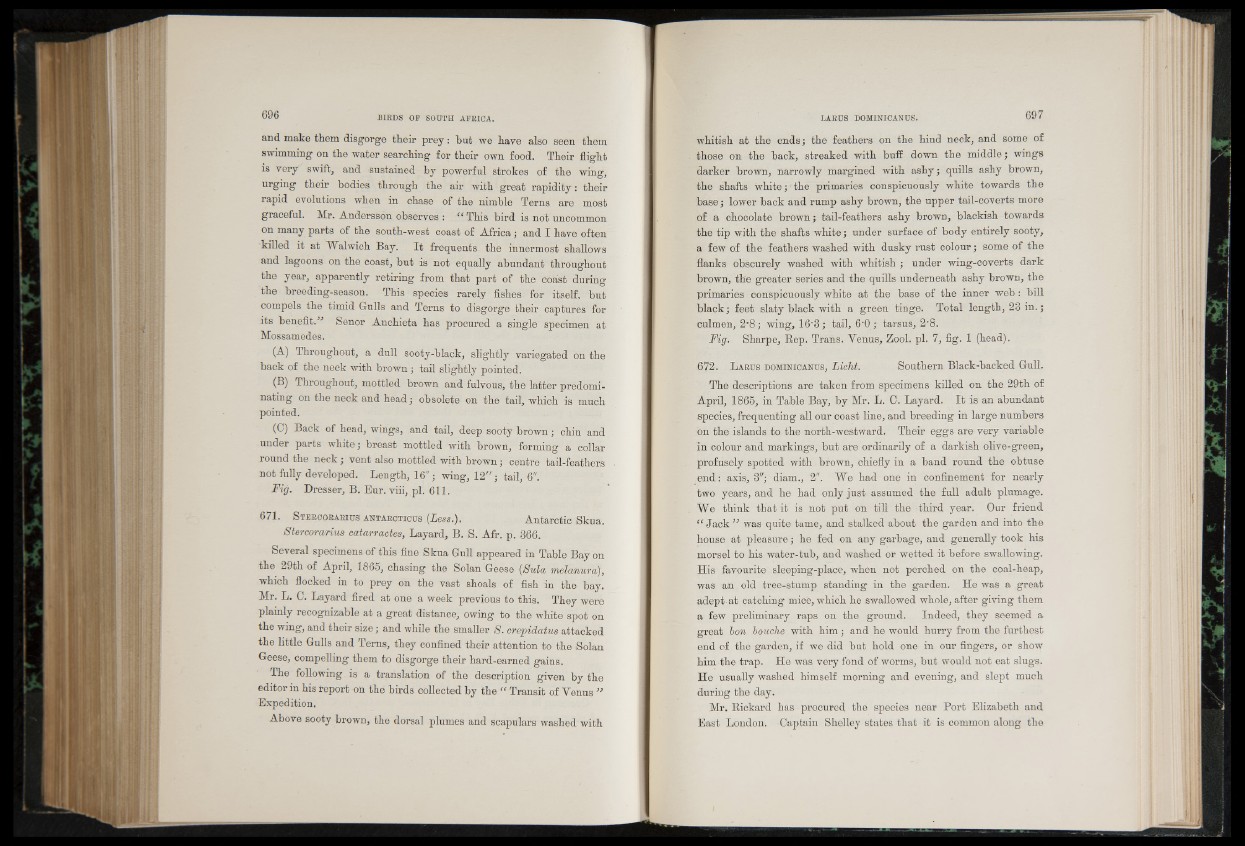
and make them disgorge their prey: but we have also seen them
swimming on the water searching for their own food. Their flight
is very swift, and sustained by powerful strokes of the wing,
urging their bodies through the air with great rapidity: their
rapid evolutions when in chase of the nimble Terns are most
graceful. Mr. Andersson observes : “ This bird is not uncommon
on many parts of the south-west coast of Africa ; and X have often
killed it at Walwich Bay. I t frequents the innermost shallows
and lagoons on the coast, but is not equally abundant throughout
the year, apparently retiring from that part of the coast during
the breeding-season. This species rarely fishes for itself, but
compels the timid Gulls and Terns to disgorge their captures for
its benefit.” Senor Anchieta has procured a single specimen at
Mossamedes.
(A) Throughout, a dull sooty-black, slightly variegated on the
back of the neck with brown; tail slightly pointed.
(B) Throughout, mottled brown and fulvous, the latter predominating
on the neck and head; obsolete on the tail, which is much
pointed.
(C) Back of head, wings, and tail, deep sooty brown; chin and
under parts white; breast mottled with brown, forming a collar
round the neck; vent also mottled with brown; centre tail-feathers
not fully developed. Length, 16"; wing, 12"; tail, 6".
Fig. Dresser, B. Eur. viii, pi. 611.
671. S tercorarius antarcticus (Less.). Antarctic Skua.
Stercorarius catarractes, Layard, B. S. Afr. p. 366.
Several specimens of this fine Skua Gull appeared in Table Bay on
the 29th of April, 1865, chasing the Solan Geese- (Sula melanura),
which flocked in to prey on the vast shoals of fish in the bay.
Mr. L. C. Layard fired at one a week previous to this. They were
plainly recognizable at a great distance, owing to the white spot on
the wing, and their size; and while the smaller S. crepidatus attacked
the little Gulls and Terns, they confined their attention to the Solan
Geese, compelling them to disgorge their hard-earned gains.
The following is a translation of the description given by the
editor in his report on the birds collected by the “ Transit of Yenus ”
Expedition.
Above sooty brown, the dorsal plumes and scapulars washed with
whitish at the ends; the feathers on the hind neck, and some of
those on the back, streaked with buff down the middle; wings
darker brown, narrowly margined with ashy; quills ashy brown,
the shafts white; 1 the primaries conspicuously white towards the
base; lower back and rump ashy brown, the upper tail-coverts more
of a chocolate brown; tail-feathers ashy brown, blackish towards
the tip with the shafts white; under surface of body entirely sooty,
a few of the feathers washed with dusky rust colour; some of the
flanks obscurely washed with whitish ; under wing-coverts dark
brown, the greater series and the quills underneath ashy brown, the
primaries conspicuously white at the base of the inner web : bill
black; feet slaty black with a green tinge. Total length, 23 in.;
culmen, 2‘8 ; wing, 16-3; tail, 6 '0 ; tarsus, 2'8.
Fig. Sharpe, Rep. Trans. Yenus, Zool. pi. 7, fig. 1 (head).
672. L arus dominicanus, Licht. Southern Black-backed Gull.
The descriptions are taken from specimens killed on the 29th of
April, 1865, in Table Bay, by Mr. L. C. Layard. It is an abundant
species, frequenting all our coast line, and breeding in large numbers
bn the islands to the north-westward. Their eggs are very variable
in colour and markings, but are ordinarily of a darkish olive-green,
profusely spotted with brown, chiefly in a band round the obtuse
end : axis, 3"; diam., 2". We had one in confinement for nearly
two years, and he had only just assumed the full adult plumage.
We think that it is not put on till the third year. Our friend
“ Jack ” was quite tame, and stalked about the garden and into the
house at pleasure; he fed on any garbage, and generally took his
morsel to his water-tub, and washed or wetted it before swallowing.
His favourite sleeping-place, when not perched on the coal-heap,
was an old tree-stump standing in the garden. He was a great
adept at catching mice, which he swallowed whole, after giving them
a few preliminary raps on the ground. Indeed, they seemed a
great ion louche with him; and he would hurry from the furthest
end of the garden, if we did but hold one in our fingers, or show
him the trap. He was very fond of worms, but would not eat slugs.
He usually washed himself morning and evening, and slept much
during the day.
Mr. Rickard has procured the species near Port Elizabeth and
East London, Captain Shelley states that it is common along the